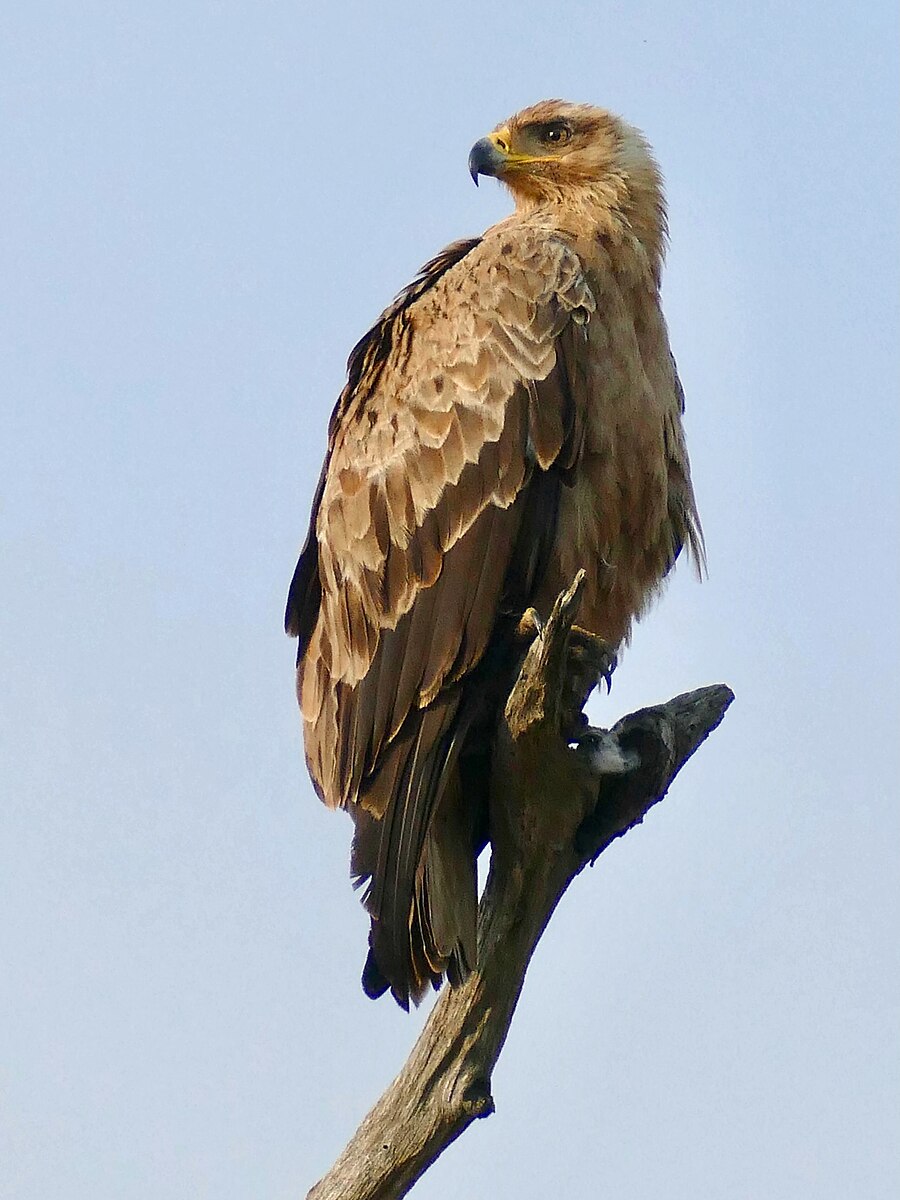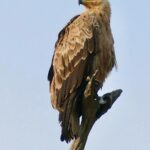The Tawny Eagle (Aquila rapax) is a large bird of prey with rich brown plumage, wide wings, and seven well-splayed “fingers” at the wingtip. Adults are entirely dark brown, while juveniles and immatures at rest show a distinctive wide white band bordered with black on the wing. In flight, this transforms into a white traverse band on the underwing that forms the base of the primary and secondary feathers.
Identifying the Tawny Eagle
- Plumage Characteristics:
- Adults are uniformly dark brown, while juveniles and immatures have a distinctive wide white band bordered with black on the wing.
- In flight, the white traverse band on the underwing forms the base of the primary and secondary feathers.
-
Birds take about four years to attain adult plumage.
-
Wing Structure:
- Tawny Eagles have structurally long, parallel-edged wings with a deeply fingered appearance.
- The 7th primary feather is long, similar to the Greater Spotted Eagle but unlike the Lesser Spotted Eagle.
-
The wings are broad like a Red-tailed Hawk’s, but longer.
-
Head and Tail Proportions:
- The head is relatively small compared to the body.
-
The tail is long, projecting farther behind than the head sticks out in front.
-
Leg and Foot Characteristics:
- The legs are stocky and relatively short.
-
The feet are large and powerful, with sharp talons for hunting.
-
Habitat and Distribution:
- The Tawny Eagle is a breeding species in Ethiopia, while the Lesser Spotted Eagle occurs on passage, and the Greater Spotted Eagle either on passage or as a scarce wintering bird around the Rift.
-
The Tawny Eagle is an extremely variable species occurring all over Sub-Saharan Africa (and in India).
-
Molting Patterns:
- The active molt in the wing (at p4) indicates an older bird, not a first-winter individual.
-
The remiges (flight feathers) are uniformly colored, lacking any distinct barring.
-
Comparison with Similar Species:
- The Tawny Eagle can be distinguished from the Lesser Spotted and Greater Spotted Eagles by its lack of distinct pale crescents at the carpal joint, the unmarked remiges and tail feathers, and its stockier proportions.
Tawny Eagle Identification in Flight
 Image source: Tawny Eagle by Bernard DUPONT
Image source: Tawny Eagle by Bernard DUPONT
- Wing Shape and Silhouette:
- The Tawny Eagle has broad, long wings with a deeply fingered appearance.
-
The wings are less rectangular and more rounded than the spotteds.
-
Underwing Pattern:
- The white traverse band on the underwing forms the base of the primary and secondary feathers.
-
This pattern is distinctive and helps differentiate the Tawny Eagle from the spotteds.
-
Tail Length and Projection:
- The Tawny Eagle’s tail is longer and projects farther behind the body compared to the head.
-
This gives the bird a distinctive silhouette in flight.
-
Head and Body Proportions:
- The Tawny Eagle has a relatively small head compared to its body size.
- The body appears more compact and less elongated than the spotteds.
Tawny Eagle Identification at Rest
- Plumage Coloration:
- Adults are uniformly dark brown, while juveniles and immatures show the distinctive white band on the wing.
-
The remiges and tail feathers are unmarked, lacking any distinct barring.
-
Leg and Foot Characteristics:
-
The legs are stocky and relatively short, with large, powerful feet and sharp talons.
-
Carpal Patch:
-
The Tawny Eagle lacks the distinct pale crescents at the carpal joint that are often visible in the spotteds.
-
Overall Proportions:
- The Tawny Eagle appears more compact and less rectangular in shape compared to the spotteds.
- The tail is longer and projects farther behind the body.
Conclusion
The Tawny Eagle is a fascinating and variable species that can be challenging to identify, especially when compared to similar eagles like the Lesser Spotted and Greater Spotted. By focusing on the key identification features, such as plumage characteristics, wing structure, head and tail proportions, and habitat and distribution, you can confidently identify this impressive bird of prey.

